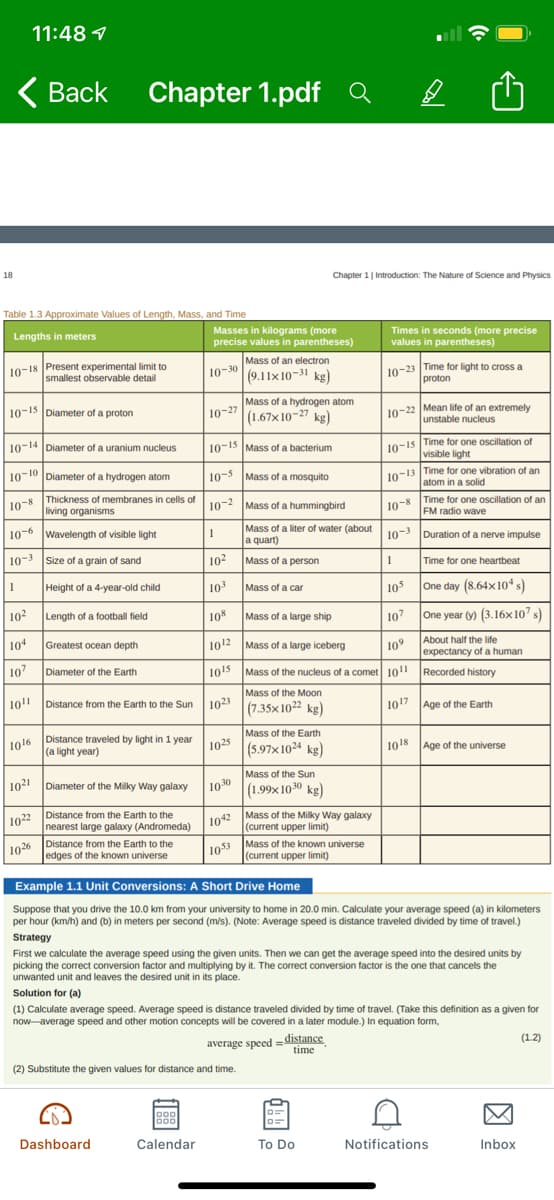Assume your hair grows at a rate of 1/44th of an inch per day. How fast is that in nm/s (nanometers per second)? Given that a typical atom is on the order of 1 x 10^(-10) m in diameter (see Table 1.3 on page 18 of the textbook), at approximately what rate does the protein synthesis that assembles your hair strands deposit atoms in units of atoms per second? I need the second question to be rounded to 1 significant digit.
Assume your hair grows at a rate of 1/44th of an inch per day. How fast is that in nm/s (nanometers per second)? Given that a typical atom is on the order of 1 x 10^(-10) m in diameter (see Table 1.3 on page 18 of the textbook), at approximately what rate does the protein synthesis that assembles your hair strands deposit atoms in units of atoms per second? I need the second question to be rounded to 1 significant digit.
Chapter10: Atomic Physics
Section: Chapter Questions
Problem 19Q
Related questions
Question
100%
Assume your hair grows at a rate of 1/44th of an inch per day. How fast is that in nm/s (nanometers per second)?
Given that a typical atom is on the order of 1 x 10^(-10) m in diameter (see Table 1.3 on page 18 of the textbook), at approximately what rate does the protein synthesis
that assembles your hair strands deposit atoms in units of atoms per second?
I need the second question to be rounded to 1 significant digit.

Transcribed Image Text:11:48 7
< Вack
Chapter 1.pdf a
18
Chapter 1| Introduction: The Nature of Science and Physics
Table 1.3 Approximate Values of Length, Mass, and Time
Masses in kilograms (more
precise values in parentheses)
Times in seconds (more precise
values in parentheses)
Lengths in meters
Mass of an electron
10-18 Present experimental limit to
smallest observable detail
10-23 Time for light to cross a
proton
10-30
(9.11x 10-31 kg)
Mass of a hydrogen atom
10-15 Diameter of a proton
10-22 Mean life of an extremely
unstable nucleus
10-27
(1.67x 10-27 kg)
10-15 Mass of a bacterium
10-15 Time for one oscillation of
visible light
10-14 Diameter of a uranium nucleus
10-10 Diameter of a hydrogen atom
10-5
Mass of a mosquito
10-13 Time for one vibration of an
atom in a solid
10-8 Thickness of membranes in cells of
living organisms
10-8 Time for one oscillation of an
FM radio wave
10-2 Mass of a hummingbird
Wavelength of visible light
Mass of a liter of water (about
a quart)
10-3 Duration of a nerve impulse
10-6
10-3 Size of a grain of sand
102 Mass of a person
Time for one heartbeat
Height of a 4-year-old child
10
Mass of a car
10 One day (8.64x10ʻ s)
102 Length of a football field
10%
Mass of a large ship
107
One year (y) (3.16x107 s)
104
Greatest ocean depth
1012 Mass of a large iceberg
10°
About half the life
expectancy of a human
107
Diameter of the Earth
1015 Mass of the nucleus of a comet 101 Recorded history
Mass of the Moon
1023 (7.35x1022 kg)
10" Distance from the Earth to the Sun
1017 Age of the Earth
1016 Distance traveled by light in 1 year
(a light year)
Mass of the Earth
1025
|(5.97x 1024 kg)
1018
Age of the universe
Mass of the Sun
1021 Diameter of the Milky Way galaxy
1030
(1.99x 1030 kg)
1022 Distance from the Earth to the
nearest large galaxy (Andromeda)
1042 Mass of the Milky Way galaxy
(current upper limit)
1053 Mass of the known universe
1026 Distance from the Earth to the
edges of the known universe
(current upper limit)
Example 1.1 Unit Conversions: A Short Drive Home
Suppose that you drive the 10.0 km from your university to home in 20.0 min. Calculate your average speed (a) in kilometers
per hour (km/h) and (b) in meters per second (m/s). (Note: Average speed is distance traveled divided by time of travel.)
Strategy
First we calculate the average speed using the given units. Then we can get the average speed into the desired units by
picking the correct conversion factor and multiplying by it. The correct conversion factor is the one that cancels the
unwanted unit and leaves the desired unit in its place.
Solution for (a)
(1) Calculate average speed. Average speed is distance traveled divided by time of travel. (Take this definition as a given for
now-average speed and other motion concepts will be covered in a later module.) In equation form,
(1.2)
average speed =distance
time
(2) Substitute the given values for distance and time.
000
Dashboard
Calendar
To Do
Notifications
Inbox
Expert Solution
This question has been solved!
Explore an expertly crafted, step-by-step solution for a thorough understanding of key concepts.
This is a popular solution!
Trending now
This is a popular solution!
Step by step
Solved in 2 steps

Knowledge Booster
Learn more about
Need a deep-dive on the concept behind this application? Look no further. Learn more about this topic, physics and related others by exploring similar questions and additional content below.Recommended textbooks for you


Stars and Galaxies (MindTap Course List)
Physics
ISBN:
9781337399944
Author:
Michael A. Seeds
Publisher:
Cengage Learning

Foundations of Astronomy (MindTap Course List)
Physics
ISBN:
9781337399920
Author:
Michael A. Seeds, Dana Backman
Publisher:
Cengage Learning


Stars and Galaxies (MindTap Course List)
Physics
ISBN:
9781337399944
Author:
Michael A. Seeds
Publisher:
Cengage Learning

Foundations of Astronomy (MindTap Course List)
Physics
ISBN:
9781337399920
Author:
Michael A. Seeds, Dana Backman
Publisher:
Cengage Learning

College Physics
Physics
ISBN:
9781938168000
Author:
Paul Peter Urone, Roger Hinrichs
Publisher:
OpenStax College

Horizons: Exploring the Universe (MindTap Course …
Physics
ISBN:
9781305960961
Author:
Michael A. Seeds, Dana Backman
Publisher:
Cengage Learning

Astronomy
Physics
ISBN:
9781938168284
Author:
Andrew Fraknoi; David Morrison; Sidney C. Wolff
Publisher:
OpenStax